September 2023
Imperialist War Criminals Meet at Hiroshima
Only Socialist Revolution Can Defeat U.S. Imperialism’s Drive To WWIII
By Maeve

May 2023: U.S. president Joe Biden and other leaders of the Group of Seven in front of building now known as the “Atom Dome.” At left, the same building, near ground zero of 6 August 1945 U.S. atom-bombing of the city.
(Photos: International Center of Photography; Brendan Smialowski / AFP)
AUGUST 6 – On this day 78 years ago, the United States dropped a new and terrifying weapon – the atomic bomb – on the city of Hiroshima, Japan. Two-thirds of the city area was destroyed. No one can say exactly how many people the U.S. bombing killed, but the Encyclopaedia Britannica tells us that more than a quarter of Hiroshima’s population was “killed outright or shortly after the blast” and that “approximately 140,000 people, or 55% of the population, were dead by year’s end.” Thousands more would die from aftereffects of the bombing.
The U.S. government’s “Target Committee” had marked Hiroshima for annihilation as the “largest untouched target” in Japan’s “larger population areas.” It noted that Tokyo was unavailable as a testing ground for the A-bomb, since it was “practically all bombed and burned out”1 already. One of dozens of Japanese cities firebombed by the U.S. Air Force, the capital city had been turned to rubble on the night of 9 March 1945, when the most destructive bombing raid in history burned 100,000 Japanese civilians alive and left 1 million homeless.
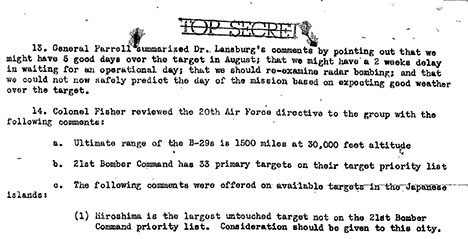 Excerpt from
U.S.' Target Committee meeting notes, 27 April 1945.
“Hiroshima is the largest untouched target....” The city was
selected as the first target of the atomic bomb also because
it was compact and located in a valley so that virtually the
entire city would be destroyed, dramatically showing the
power of the bomb.
Excerpt from
U.S.' Target Committee meeting notes, 27 April 1945.
“Hiroshima is the largest untouched target....” The city was
selected as the first target of the atomic bomb also because
it was compact and located in a valley so that virtually the
entire city would be destroyed, dramatically showing the
power of the bomb. But now the nuclear message of terror was to be repeated: Nagasaki was next on the A-bomb list. President Harry Truman’s committee had chosen it too for mass death, he had approved the decision, and so, on 9 August 1945, the second A-bomb was dropped there.
The United States remains the only country to have used atomic bombs in war. In 1945, its cold-blooded murder of hundreds of thousands at Hiroshima and Nagasaki sent the message that the atomic bomb was ready for use against the Soviets and all who might stand in the way of American imperialism’s drive for world domination. In 2023, “our” capitalist rulers are driving toward a thermonuclear Third World War. The only way to prevent this is the revolutionary overthrow of this long outlived and deadly system, by the world’s working class.
Often, if we’re taught about Hiroshima at all, it’s just a quick and hazy reference; war criminals on the winning side largely get a pass. A central goal of this issue of Revolution is to show the connection between U.S. imperialism’s calculated mass murder then and the escalating threat it poses now. A powerful eyewitness account of the aftermath of the Hiroshima bombing and a Marxist review of the film Oppenheimer in this issue help show this crucial link. So too do the photos at the beginning of this article.
The Meaning of Their Message
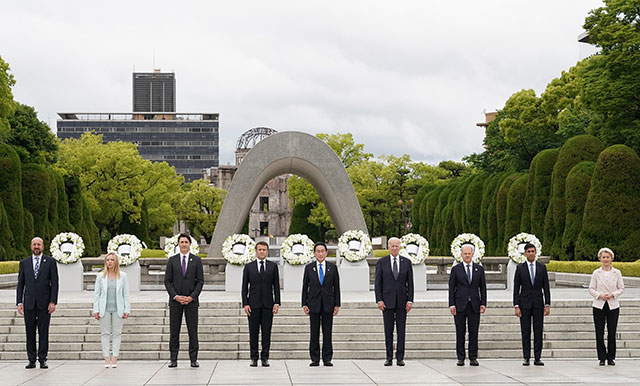
War criminals all: leaders of the G7 leading imperialist powers, flanked on left and right by heads of the European Union, hypocritically lay wreaths on the site of the 1945 atomic bombing of Hiroshima, Japan, on May 19 while preparing further escalation of the war on Russia over Ukraine. (Photo: Government of Japan)
On May 19 of this year, U.S. imperialism’s current commander-in-chief Joe Biden, harking back to his Democratic predecessor Truman, used Hiroshima as a symbol and a threat. At the head of a conclave of imperialist leaders known as the Group of Seven (G7), he posed for a photo op, in front of the only structure left standing in the area where the U.S.bomb exploded in 1945. Known today as the “Atom Dome,” back then it was an exhibition hall, located about a third of a mile from Shima Hospital, which was ground zero of the A-bomb’s blast.
The G7 is made up of six North Atlantic Treaty Organization powers: the U.S., Britain, Canada, France, Germany and Italy, plus Japan, which cooperates closely with NATO. Its gathering was followed on May 20 by a meeting of the Quad “Indo-Pacific” partnership (the U.S., Australia, India and Japan), also held at Hiroshima.
When we revolutionary Marxists describe the meaning of Biden & Co.’s message, it’s not guesswork. The official U.S. broadcasting network proclaimed that “a strong signal was sent to Russia and China as both the G7 and the Quad groups met at Hiroshima, the site of the first atomic bomb attack.” It went on to quote a U.S. foreign-policy pundit who “predicts ‘a more confrontational direction with the West on one side, and China and Russia on the other’” (Voice of America, 20 May).
Did the U.S., UK, France, Germany, Italy and Japan – whose
historic and present-day crimes against the peoples of the
world cannot even begin to be enumerated here – send their
leaders to Hiroshima merely to grin into the cameras, lay
some wreaths for “peace” (sic) and trade platitudes
about “economic resilience”? (The U.S., top dog of world
imperialism, plus the other six G7 powers have a combined
GDP of $40 trillion, just under half of the global economy.)
No – heading the official Fact Sheet on their summit is
“United on Ukraine” and “United on China” (whitehouse.gov,
21 May). United, that is, in the U.S./NATO proxy war against
Russia that the imperialist powers are waging as a way
station toward war against the Chinese bureaucratically
deformed workers state.2
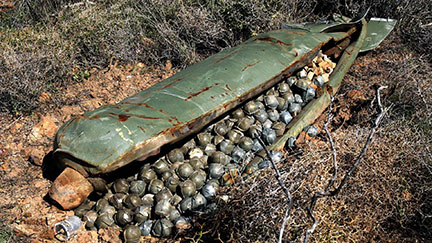 The U.S. has begun
delivering cluster bombs (left) to Ukraine, which has
regularly used this particularly deadly munition against the
Russian-speaking civilian population of Donetsk and Lugansk,
where in the assault by fascist-led Ukrainian forces over
14,000 people were killed from 2014 to 2021.
The U.S. has begun
delivering cluster bombs (left) to Ukraine, which has
regularly used this particularly deadly munition against the
Russian-speaking civilian population of Donetsk and Lugansk,
where in the assault by fascist-led Ukrainian forces over
14,000 people were killed from 2014 to 2021. In point 1 of the “G7 Hiroshima Leaders’ Communiqué” (20 May), they vow to “support Ukraine as long as it takes.” Then they “commit to intensifying ... military support.” (So far since February of last year, the U.S. has officially pumped in $43 billion in military aid, and this July it signed a declaration pledging “long-term security guarantees” to Ukraine.) The G7 communiqué goes on to blow some of the usual smoke about “disarmament” and wishing for “a world without nuclear weapons,” while the U.S. has 5,244 nuclear warheads (Bulletin of the Atomic Scientists, 16 January) – and in July Biden announced that he would send widely banned cluster bombs to Ukraine, as part of an $800 billion infusion of military aid.
As for “unity on China,” the G7 communiqué pledges to “support a free and open Indo-Pacific” region, echoing Britain’s Opium Wars against China and the U.S.’ demand for an “Open Door” there going back to when its bloody 1898 conquest of the Philippines expanded its foothold in Asia. Early this year, Air Force general Mike Minihan sent a memo “predicting the U.S. will be at war with China in two years” (NBC News, 28 January), while the former chief of the U.S. Indo-Pacific command, retired admiral Philip Davison, warned that a war with China over Taiwan might begin by 2027 (Sydney Morning Herald, 7 March).
Hiroshima 1945 and Today’s U.S. War Drive
For the occasion of the 50th anniversary of the A-bombing of Hiroshima, the co-chair of Princeton’s International Policy program published an analysis, in Foreign Affairs, the journal of the foremost foreign-policy think tank, of why the U.S. decided to drop the bomb in 1945.
“Of central importance, [Truman’s Target Committee] stressed that the bomb should be used as a terror weapon – to produce ‘the greatest psychological effect against Japan’ and to make the world, and the U.S.S.R. in particular, aware that America possessed this new power. The death and destruction would not only intimidate the surviving Japanese into pushing for surrender, but, as a bonus, cow other nations, notably the Soviet Union” (which was about to invade Manchuria).
And through this act of terror, Washington “could help shape the postwar world.”3
What about today? The U.S./NATO powers and allies met at Hiroshima this May to send a message from the ground zero of nuclear terror. Evoking the mushroom clouds of August 1945, their message was about imperialist war today and in the future. But in the words of one Revolution reader: “I get it about World War Two, but how come you Trotskyists say the U.S. is using people in Ukraine now as cannon fodder in a drive for war later on against China – does that even make sense?”
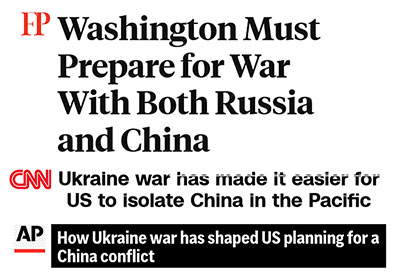
Don’t take our word for it. “Washington Must Prepare for War with Both Russia and China,” proclaimed Foreign Policy (18 February 2022), right before the start of the current war. A year later, an AP report, headlined “How Ukraine war has shaped US planning for a China conflict” (16 February), noted: “As the war rages on in Ukraine, the United States is doing more than supporting an ally. It’s learning lessons – with an eye toward a possible future conflict with China,” which “remains America’s biggest concern.”
There’s plenty more. “Ukraine war has made it easier for U.S. to isolate China in the Pacific,” enthused CNN (6 March). Then Foreign Policy (13 March) weighed in again: “A Russia diminished and made less threatening by Ukraine will also allow for an even more decisive U.S. pivot to Asia later. Military aid to Ukraine should therefore be prioritized....” The theme was repeated again and again; as in prior wars, the bourgeois media beat the war drums, both echoing and being echoed by, the White House and Pentagon masters of war.4
Let’s recall as well that last year Biden, predictably going back on a campaign promise, signed off on a “fundamental role of U.S. nuclear weapons” policy that leaves the door open for first use of nuclear arms “to defend the vital interests of the United States or its allies and partners.” While escalating its saber-rattling over “threats to our national security” from a “rising China,” Russia, etc., it is U.S. imperialism and its NATO allies that are driving toward World War III. Seven-plus decades after it dropped the atom bomb on Hiroshima, then developed weaponry 1,000 times more powerful (the H-bomb), the U.S. has approximately 750 bases in 80 countries around the world, with nukes in five NATO member counties (Council on Foreign Relations, 30 March). As we wrote in our previous issue (Revolution, No. 19, August 2022):
“Today, as throughout the Cold War, the U.S. has nuclear missiles stationed in bases across Western Europe; aimed directly at the USSR until its dissolution, since then they’ve been aimed at Russia. With the current war set off by the U.S./NATO drive to encircle post-Soviet, now capitalist Russia, the decades-old ‘doomsday clock’ ticks closer to nuclear midnight. As we have indicated here, history amply shows that U.S. imperialism poses the biggest, clear and present, danger to the world. Intransigently opposing ‘our own’ imperialist bourgeoisie, revolutionaries call for revolutionary internationalist struggle to defeat its on-going war drive against Russia and China.”
The threat that Biden & Co. broadcast from Hiroshima this May highlighted that the U.S./NATO imperialists, who threaten to blow up the world with their war drive against Russia and China, must be defeated. The workers and oppressed worldwide have a vital interest in defending Russia, China and other countries on the imperialists’ hit list against this war drive heading toward WWIII, while giving no political support to their governments. To put an end to the menace of a new, nuclear world war that imperialism has held over humanity’s head since 6 August 1945, we fight for new proletarian revolutions like the one led by V.I. Lenin and Leon Trotsky’s Bolsheviks in 1917.
What They Did and What They Intend to Do

As Australian journalist John Pilger notes in his article “Another Hiroshima Is Coming ... Unless We Stop It Now” (excerpts of which we reprint on page 3): “The atomic bombing of Hiroshima and Nagasaki was an act of premeditated mass murder....” When we read about what happened there (or in the less-discussed firebombing of Tokyo), we are faced with realities that can seem impossible to bear. We get glimpses in Pilger’s article, and in books like John Hersey’s Hiroshima, which in 1946 brought accounts by six survivors of the U.S. A-bombing to millions of readers.
In Steven Okazaki’s intensely moving documentary White Light/Black Rain: The Destruction of Hiroshima and Nagasaki (2007), 13 Japanese men and women who were mainly children or teenagers at the time, together with a woman who was part of the Korean community in Hiroshima, courageously tell us what it was like for them when the A-bombs hit.
The story of Hiroshima was told in a different way when the pioneering anime film Hadashi no Gen (Barefoot Gen) came out in 1983. It is based on the historical manga (graphic novel) series by Keiji Nakazawa, who was six when he lived through the atom-bombing of Hiroshima, his hometown. Among many other works, a small volume titled The Bomb (2010), by popular left-liberal historian Howard Zinn, opens with a wrenching account by Kinuko Laskey of what she experienced as a 16-year-old schoolgirl when the bomb exploded there.
We urge our readers to seek out these and other accounts. Here we will cite just one of the many excerpts included in Richard Rhodes’ The Making of the Atomic Bomb (1986). It is from a six-year-old boy:
“Near the bridge there were a whole lot of dead people. There were some who were burned black and died, and there were others with huge burns who died with their skin bursting, and some others who died all stuck full of broken glass. There were all kinds. Sometimes there were ones who came to us asking for a drink of water. They were bleeding from their faces and from their mouths and they had glass sticking in their bodies. And the bridge itself was burning furiously....”5
Two months before, U.S. Secretary of War Henry Stimson recorded in his diary (7 June 1945) some comments that he had made during a meeting with Truman, noting that he had told the president he was a “little fearful that before we could get ready the Air Force might have Japan so thoroughly bombed out that the new weapon would not have a fair background to show its strength.” Stimson was just one of the U.S. officials giving voice to the eagerness to test the A-bomb on a large populated area, an urgency that combined with the government’s urgent desire to use this to “subdue the Soviets” (see review of Oppenheimer on page 24.)
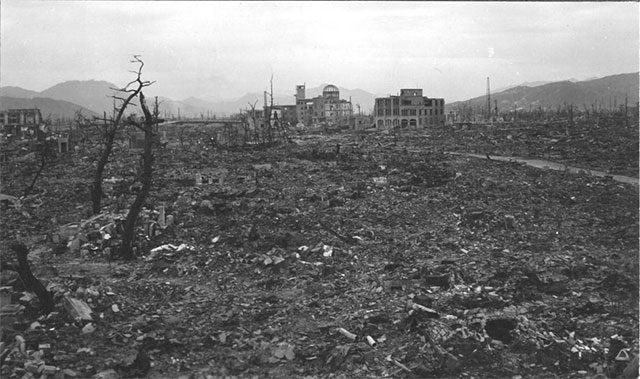
Horrific U.S. war crime: aftermath of the atomic bombing of Hiroshima, August 1945. (Photo: U.S. National Archives)
In August, when Truman received word that the bomb had worked, destroying Hiroshima, he declared: “This is the greatest thing in history” (Newsweek, 5 August 2020).
And what of the war criminals who had made Tokyo, Osaka, Yokohama and so many other Japanese cities “unsuitable” for A-bombing because U.S. terror firebombings had already reduced enormous swathes of them to corpse-strewn rubble?6 Among these men were Major General Curtis LeMay, who as head of the 21st Bomber Command planned and organized the low-altitude incendiary bombing of Tokyo and other cities. (He later went on to advocate that the U.S. bomb Vietnam “back into the Stone Age.”) LeMay’s assistant and tactical analyst for the firebombings was Robert McNamara, who became president of Ford Motor Company before overseeing the genocidal U.S. war against Vietnam as Secretary of Defense under JFK and Lyndon Johnson, later moving on to head the World Bank.
Years after leaking the “Pentagon Papers,” the U.S. military’s inside story of the U.S. War on Vietnam, former war-planning expert Daniel Ellsberg recounted some of what he knew about “general war plans” for the use of hydrogen bombs and other weapons in a world war against the “red menace.” These had projected roughly 600 million direct deaths, including not only the Soviet Union and China but also through “collateral damage” in U.S.-allied and neutral countries. At this point one can only surmise what the Pentagon’s detailed plans for war against China entail.
Almost 78 years after the U.S. imperialists unleashed atomic death and destruction on Hiroshima, the current Democratic warmaker-in-chief, at the head of the G7 grouping of imperialist powers whose wars have piled up tens of millions of corpses, went to Hiroshima. Together they broadcast far and wide the message that they are driving toward a new world war. The imperialists cannot and will not be coaxed, pressured or voted out of it. Pacifist pleas asking them to disarm won’t do it; the task is to “defeat, expropriate and disarm the bourgeoisie,” as Lenin wrote during the first imperialist world war. The Bolsheviks’ revolutionary-internationalist program of class war against imperialist war points the only way forward today: the imperialists can and must be stopped and overthrown – only international socialist revolution will stop them. ■
- 1. See “Review of Oppenheimer: Socialism or Nuclear Armageddon” in this issue of Revolution. At the Target Committee’s third meeting (28 May 1945), in which it decided the bomb should be aimed at the center of Hiroshima, it noted that “with the current and prospective rate” of bombings by U.S. air forces, “it is expected to complete strategic bombing of Japan by 1 Jan 46 so availability of future [A-bomb] targets will be a problem.” The committee’s minutes are reproduced online as part of the National Security Archive (nsarchive2.gwu.edu) “briefing book” on the atomic bomb.
- 2. The victory of the Chinese Revolution (1949) led to expropriation of capitalists and landlords, laying the basis for a planned, collectivized economy. But from its inception the Peoples’s Republic of China has been governed by a privileged Stalinist bureaucracy. Despite capitalist inroads, it remains a deformed workers state that Trotskyists defend against imperialism and counterrevolution, while calling for a proletarian political revolution to open the way to socialism.
- 3. Barton J. Bernstein, “The Atomic Bombings Reconsidered,” Foreign Affairs, January-February 1995.
- 4. See “You Furnish the Pictures, and I’ll Furnish the War,” Revolution No. 19, September 2022.
- 5. In Hiroshima Nagasaki (2011), author Paul Ham states: “The schools ‘completely burned’ or ‘totally destroyed’ in Hiroshima included 21 middle (secondary) schools and 18 grammar schools. Schools partially destroyed included eight junior high schools and six grammar schools. Of the 12,000 schoolchildren aged between 12 and 17 who worked in the city as mobilised labour – and who had attended these schools – 8500 were killed instantly or within weeks; most of the surviving child labourers were severely wounded and irradiated.”
- 6. In February 1945, the historic German city of Dresden was also immolated by firebombing when the U.S. and British air forces dropped over 2,500 tons of explosives and incendiaries, massacring tens of thousands of people.
